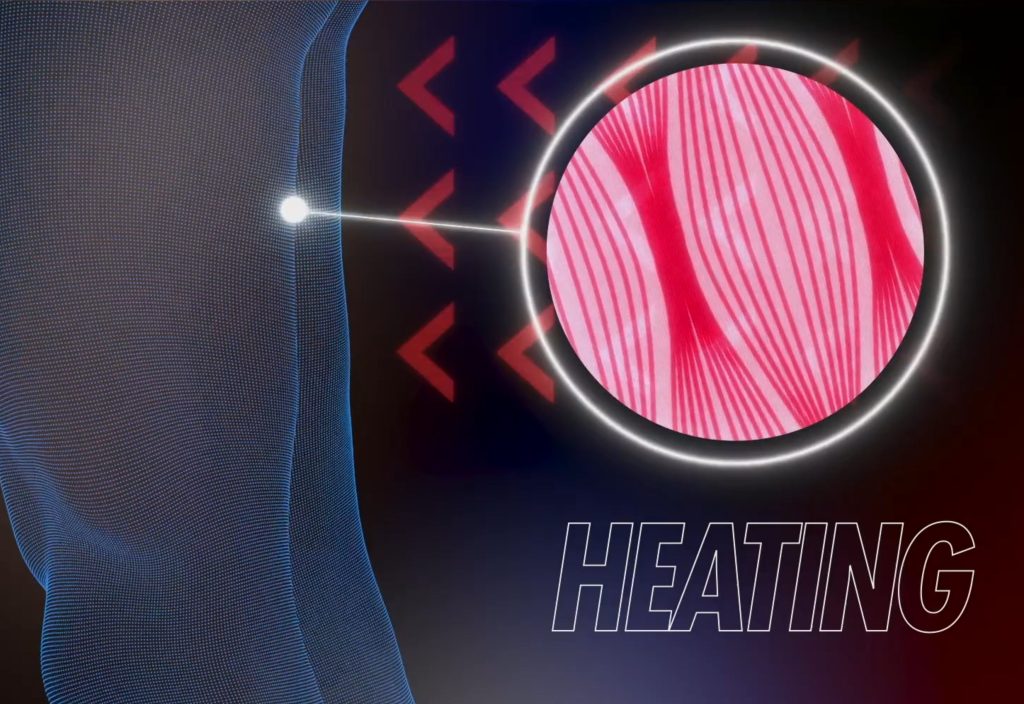Using heat for warm-ups
There are various schools of thought around pre-exercise warm-ups; the best way to warm up, how long to do it for are often up for debate; but the one thing that’s universally agreed is that they’re important.
Why are
warm-ups so important?
Warming up is a crucial step in preparing the body for exercise. By stimulating the cardiovascular system, it helps prevent injuries and reduce soreness by increasing blood flow and raising body temperature.
Warm-ups are best tailored to specific exercises, ensuring that the key muscles used in the sport are activated. For example, a runner’s warm-up will differ from a football player’s warm-up, focusing on the specific muscle groups required for each activity.
A comprehensive study conducted in Norway examined the injury rates of a thousand female football players who warmed up before workouts compared to several hundred who did not. The results revealed that those who performed warm-ups experienced fewer injuries overall, as well as a reduction in overuse injuries. Any injuries that did occur were less severe.
In addition to injury prevention, warm-ups also serve to elevate body and muscle temperature. By doing so, they ensure that the muscles are not cold and stiff when training begins.
Increasing muscle temperature facilitates the body’s ability to move and perform various activities without excessive strain. It also helps muscles adapt to performing under stress and meet the oxygen requirements associated with specific exercises.

Why use local heat application in warm up?
Applying heat directly to the surface of the skin can penetrate heat directly into the muscles, and can have the same effect as active exercise to warm-up.
Studies (2-4) have shown that an elevated tissue temperature increases the amount of elongation obtained from a stretch. Applying superficial heat simultaneously with a low-load static stretch was found to improve flexibility, compared with stretching alone in a number of additional studies (5,6,8&9) .
Although the most common time to adopt recovery strategies is post-exercise/competition, research into use of heat (7) has also evaluated the effects of applying heat before (pre-heating) or after (post-heating) activity or injury.
The study suggests that increasing muscle temperature to approximately 40°C may be necessary to induce beneficial effects on muscle.
The findings suggest that heating >16 hours before exercise/stress seems to produce beneficial results compared with heating immediately before exercise/stress, however heating during activity also seems to provide beneficial effects.

Using
ProMOTION EV1
ProMOTION EV1 provides accurately controlled heat therapy. Its thermoelectric technology requires no ice, water, or mains electricity, making it fully portable and convenient to use.
It heats to and accurately maintains a temperature of 40 degrees Celsius, the optimal therapeutic range advised.
The targeted nature of ProMOTION EV1 allows users to accurately target heat application on selected muscles or muscle groups. Ideal for pre-activation of muscles during the latter stages of injury recovery.
Adding compression, alongside the heat application can help the heat penetrate deeper into the tissues.

References
- Knight CA, Rutledge CR, Cox ME, Acosta M, Hall SJ. Effect of Superficial Heat, Deep Heat, and Active Exercise Warm-up on the Extensibility of the Plantar Flexors. Physical Therapy. 2001;81(6):1206-14.
- Lehmann JF, Masock AJ, Warren CG, Koblanski JN. Effect of therapeutic temperatures on tendon extensibility. Arch Phys Med Rehabil. 1970;51(8):481-7.
- Warren CG, Lehmann JF, Koblanski JN. Heat and stretch procedures: an evaluation using rat tail tendon. Arch Phys Med Rehabil. 1976;57(3):122-6.
- Warren CG, Lehmann JF, Koblanski JN. Elongation of rat tail tendon: effect of load and temperature. Arch Phys Med Rehabil. 1971;52(10):465-74 passim.
- Lentell G, Hetherington T, Eagan J, Morgan M. The use of thermal agents to influence the effectiveness of a low-load prolonged stretch. J Orthop Sports Phys Ther. 1992;16(5):200-7.
- Henricson AS, Fredriksson K, Persson I, Pereira R, Rostedt Y, Westlin NE. The effect of heat and stretching on the range of hip motion*. J Orthop Sports Phys Ther. 1984;6(2):110-5.
- McGorm H, Roberts LA, Coombes JS, Peake JM. Turning Up the Heat: An Evaluation of the Evidence for Heating to Promote Exercise Recovery, Muscle Rehabilitation and Adaptation. Sports Med. 2018;48:1311-28.
- Soysal ANO, Şimşek Ş, Özdemir AK, Korkmaz MB, Aslan UB. Comparison of the Effects of Superficial and Deep Heat Agents on Hamstring Muscle Flexibility in Healthy Individuals. J Clin Pract Res. 2023;45(4):000-.
- Derbachew A. Flexibility Augmented by Heat-applied Stretching Exercise Compared to Exercise Without Additional External Heat. American Journal of Life Sciences. 2020;8(4):69-75.
- Petrofsky J, Bains G Fau – Prowse M, Prowse M Fau – Gunda S, Gunda S Fau – Berk L, Berk L Fau – Raju C, Raju C Fau – Ethiraju G, et al. Dry heat, moist heat and body fat: are heating modalities really effective in people who are overweight? (1464-522X (Electronic)).